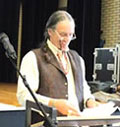Hi folks
In this newsletter, we begin a series on coaching senior leadership teams (SLT). Because team coaching is becoming more common, I suspect you will find it useful in many ways. Many SLTs are discovering that though they might be excellent individual leaders for their direct reports, they are not as astute at influencing peers and the CEO. As such, the SLTs suffer from frustration and irritation instead of capturing the value of 1 + 1 = 3. In general terms, all SLTs should be more than the sum of the parts. In present day terms, Stanford has coined this phenomenon "collective impact" where change emerges from the collage created by the individuals composing the SLT.
This first newsletter will focus on the technical aspects of forming the SLT. If the SLT has not defined and negotiated the roles, responsibility, authority and communication of the SLT and each member, there is great likelihood that misunderstandings and mishaps will evolve. As we progress further into the series, we will go deeper into the team dynamics.
As always, the articles will be written from both the perspective of the SLT and the coach.
The details of the advanced coaching workshop are listed at the end of the newsletter. Cutting edge topics we will explore:
Contact Model: The latest applications and insights from my contact model will be reviewed. It can be used to redirect your clients toward more effective leadership behavior. The dynamics between presence and vulnerability will support you to track your client (and yourself).
Team/Peer Coaching: A powerful team development process involves two methods. One is coaching the team and its dynamics. The other is supporting the team to peer coach each other through specific techniques. At first, it can seem too structured. However, when applied it creates an emergent process that leads to more effective team processes.
Self Awareness: A critical aspect of effective coaching is your self awareness. We will use several assessment tools. First, you will take the assessments and review them for your personal understanding. Then we will spend significant time applying the information to provide a 3-dimensional understanding of your strengths and undeveloped flat-sides. You will take the MBTI Step 2, Form Q which reveals your preferred behavior that can create unintended consequences. We will review your preferred conflict style through the Thomas-Kilmann Instrument so that you can track your response in terms of assertiveness and cooperation. Finally, we will review the FIRO-Business which addresses your preferred interpersonal style around connection, control, and involvement. Combined, these three assessments create an action learning process as you will learn about yourself while learning how to coach the 3-dimensions.
Finally, I've included a link for an executive retreat in Ireland: www.burrenleadership.org. If you have clients that need a complete break to recharge and have a magical experience, you might consider this program. Mary Stacey one of the developers of the program is a dear friend and colleague.
As usual, if you find the newsletter useful, please pass it along to colleagues. If not, simply unsubscribe. Either ways, thanks for reading the newsletter.
Respectfully,
Herb Stevenson
Herb Stevenson, CEO/President
Cleveland Consulting Group
Coaching Senior
Leadership Teams (SLT)
Through Formation and/or into Functionality
Herb Stevenson
March 31, 2014
On the surface, you wouldn't think that assembling a functional senior leadership team would pose a significant problem to the typical CEO. After all, senior leaders are an organization's best and brightest. They've progressed through the ranks, demonstrated their abilities, and proven that they get along well with their colleagues and the people who work for them. So why are so many senior leadership teams unproductive and possibly counter-productive?
"You cannot create real teams by convening a set of people and calling them a team."
As coaches, we are being asked to formally assist in the formation and/or to facilitate through extremely difficult tensions amongst senior leadership team members. Over the course of the last several year, it has become clear that many SLTs are dysfunctional at best. Some of the difficulty is related to the lack of awareness of how to work with peers, where authority and positional power are equal and interdependency is a fact of success.
As SLTs are formed, it is surprising how many have never taken the time to define and negotiate a basic charter surrounding authority, responsibility, commitment, and communication. In short, a set of defining boundaries. At a minimum, the CEO, if forming the team, needs to establish a clear purpose for the team; otherwise, it will fragment and be unproductive.
Coaching the CEO
As the CEO decides to form or reformulate the SLT, there should be some coaching on the following:
"Many chief executives make the mistake of assuming that if the team members know the organization's mission statement, then they understand the team's purpose."
The CEO must have a clear vision for the SLT, and must articulate his or her perspective to others. Otherwise, we have multiple opinions about what is the business of the team and how it should function. It is surprising how many times each member of the SLT has a history of experiences from prior teams, none of which apply to the present SLT.In a global economy and the "constant white water" of day-to-day work life, it is imperative that the CEO be sensitive to, and empathetic toward, the anxiety that results from continual change. This will show up in the frustration of team members either as abrasiveness or being checked out. Grounding the team at each meeting and staying focused on the work at hand will support their effectiveness
The CEO must be willing to share power in order to gain power, rather than hoarding it. If the SLT is to be functional, a balance between the authority of the CEO to make appropriate decisions and the necessary unabashed dialogue that is needed from the SLT to make quick and effective decisions is imperative. Defining and negotiating these dynamics will pay massive dividends.
"Clarifying the team boundaries often involves some pain and some difficult conversations about who is and is not on the team."
In that same vein, the CEO, especially new leaders will need to chose colleagues whose skills complement, rather than resemble, their own. Often the titles decide who becomes members of the SLT; thereby, ensuring that the meetings are more show and tell than decisive. In today's environment, a base team with key contributors floating in and out is one effective method.
Coaching Guidance for Measuring Success
CEOs and SLTs find measuring their own effectiveness nearly impossible. Instead,
stockholders, customers and employees are in a much better position to evaluate them, since the teams' performance directly affects these constituencies. Nonetheless, the trap can become that so long as all stakeholders are happy, then the CEO and SLT must be effective.
"Most top leaders who avoid developing or leveraging the power of a real top management team do so out of ignorance."
One thing you can coach the CEO how to determine the effectiveness by how well the team members interact and set the stage for future collaboration. Bickering and petty disagreements do not foster productive long-term relationships, but robust discussion does. The team experience should develop the top leaders'; therefore it is the responsibility of the CEO to see the SLT as an opportunity for executive development. At a minimum, the SLT should learn new capabilities, increase their knowledge and gain insight into interpersonal relationships. For example the coach could have the CEO take these three "essential steps" to assemble the team:
Assemble a team whose members can work collaboratively on enterprise issues and who will respect the rules of engagement the CEO defines and negotiates. Where needed, training can be provided in how to create effective collaboration and dialogue.
Establish the team's direction in line with corporate goals. Though frustrating for some SLTs, the rewards are immense when alignment is clearly developed and shared versus the individual perceptions that "we already know" when they don't.
Choose team members based on enterprise perspective and collaborative ability rather than title.
Pitfalls
During the define and negotiate process with the team, there should be some formal mechanism to support the following three processes:
Create a structure that enables team members to focus on strategic initiatives rather than small tactical issues. Pettiness can riddle the best SLT when it is dragged down into the weeds. An assignment to the appropriate SLT member should be for any tactical issues; otherwise, the SLT will get lost in their own pettiness.
"White water", the state of constant turbulence, ensures that team members feel short on time and resources. The CEO should ensure that the SLT has sufficient time for robust debate and have access to the resources they need to do their work. If not, the meeting will focus on those two issues, time and resources, instead of the strategic initiatives.
The coach will need to constantly maintain a vigilance for using the meetings for executive development. The CEO (or coach initially) should provide direct interventions into the team process to help members learn better team strategies over time. Coaching for Success
"It is a fact of group life that members tend to load their negative feelings onto the person who is most different from the majority. If a senior team has only one person of a different race, gender [or] age... that person may come to be viewed as a 'problem member'."
Improving the performance of a senior leadership team can be challenging, yet extremely gratifying. Some teams find that they cannot address their problems without the assistance of a coach. A good coach – whether it's the CEO, a team leader, a team member or an outsider – helps team members recognize behaviors that enhance or hinder teamwork. The coach ensures that team members stay on task, avoid inflammatory language during discussions and respect boundaries.
In fact, coaching can improve even the most self-sufficient team. Almost every team develops a self-correcting capability, and sometimes team members emerge as the most qualified leaders. The wise CEO (and coach) nurtures and takes advantage of the situation by developing their talent.
Coaching is especially helpful throughout the developmental process. At each point, the team needs a different kind of coaching:
Beginning – During the start-up, there will be a period of forming and storming as everyone tries to get a sense of how the team dynamics will evolve. The coach or CEO needs to articulate the team's purpose; establish a team identity – a sense of "us"; and agree on "norms and expectations." When teams go wrong, the problem is often that they never established their purpose and identity at the onset.
Middle – As the team settles, it will begin to normalize itself. The team members have some experience working together. The time is right for the CEO or coach to stop for a moment to ask, "How is it going?" and to change behaviors and structures that aren't working. If things are really going astray, the team leader may need to refocus the group strongly and openly. Bad behavior of any sort fits into this category.
End – As the team performs over time, it is a good to review projects or fiscal period to look back on its successes and failures. To be able to witness itself is a form of action learning that will ensure continued development.
Regardless of who coaches the team, the SLT should feel a sense of adventure and excitement when the team first forms. If they're merely going through the motions, they will not produce the cutting-edge thinking that a group of senior leaders ought to provide. CEOs are responsible for instilling a sense of commitment to the team purpose.
Resources:
Leadership Team Coaching: Developing Collective Transformational Leadership by Peter Hawkins, 2011. Kogan-Page.
Senior Leadership Teams: What it takes to make them great by Ruth Wageman, Debra A. Nunes, James A. Burruss, J. Richard Hackman 2008 Harvard Business School Publishing Corporation.
The New Global Leaders: Richard Branson, Percy Barnevik, David Simon And the Remaking of International Business by Manfred F.R.Kets de Vries with Elizabeth Florent-Treacy, 1999. Jossey-Bass.
Executive & Life Coaching:
A Journey into Advanced Skill Building
May 4-9, 2014
Punderson State Park, Cleveland Ohio
 Executive & Life Coaching: A Journey into Advanced Skill Building is a “coming- home” experience for those seeking to build upon their existing coaching skills. It is an indepth experience steeped in personal growth through self awareness and professional development through a refinement of your coaching/consulting skills. Though based in gestalt/ontological theory, the core concepts will be “use of self”, “presence” and “paradoxical theory of change” which permeate many coaching philosophies. In addition, we will include a form of peer coaching that is gaining momentum as a leader development process as well as a team development process.
Executive & Life Coaching: A Journey into Advanced Skill Building is a “coming- home” experience for those seeking to build upon their existing coaching skills. It is an indepth experience steeped in personal growth through self awareness and professional development through a refinement of your coaching/consulting skills. Though based in gestalt/ontological theory, the core concepts will be “use of self”, “presence” and “paradoxical theory of change” which permeate many coaching philosophies. In addition, we will include a form of peer coaching that is gaining momentum as a leader development process as well as a team development process.
Intensive
Executive & Life Coaching: A Journey into Advanced Skill Building is an intensive experience that requires a commitment to expand your knowledge and practice. This translates into an extensive manual of original writings from my 30 years of executive coaching and consulting. In addition, supporting articles that influenced the writings will be available to further deepen your practice knowledge. In short, reading to deepen will support your process.
Know-Do Gap
Robert Sutton coined the phrase, the “know-do gap” to explain that to fully embrace new learning it requires increasing the knowledge base (know) and then directly applying it through various practical experiences (do). As such, the workshop will be a mix of learn a little then do a little.
 Maximizing Your Experience
Maximizing Your Experience
Many coaching workshop experiences are viewed as learn a little from the teaching at the workshops and do a lot, with the emphasis on not reading in advance. Attendees are strongly encouraged to complete the readings in advance to maximize the experience by eliminating the Know-Do gap. If you decide to skip the readings until after the workshop, it will reduce your overall experience, but not be a deterrent to your learning.
Foundational Assumptions
We will be working in a field of energy. Hence the field phenomena will constantly impact every one. As we become more present, our capacity to have a refined form of “seeing” the various models will occur. Being open to new ways to perceive is an important aspect of the program.
We also will be impacting each other. Hence, we will be practicing the learn, apply, learn, do, learn, apply aspect of action learning/research. This can cause some discomfort, however its assumed that to learn, we must lean into our discomfort.
Taking Care of You
Each morning there will be the choice to do a walkabout on the beautiful land of the Punderson Park or to do your personal Yoga or to do a quiet reflective time near the lake. It is imperative that you grant yourself the time to rejuvenate while at this workshop. We encourage you to unplug from work if at all possible.
Assessments
There are several assessments that will need to be completed prior to arriving. The first is a detailed reflective process that will support your understanding of how you are coming into the workshop. If you do the Monday night optional class, it will be an absolute necessity. In addition it will be part of the Sunday night opening of the circle.
You will also be provided information for competing the MBTI Step 2, Form Q, the Thomas Kilmann Conflict Instrument, and the FIRO-Business. These are important as you will use class time to build your individual development plan to be implemented when you return to your practice.
The individual development plan is a reflective tool to increase your application and learning from the workshop. You are encouraged to work on it in the open evenings
 Professional Requirements
Professional Requirements
Participants will be supported by having completed a coaching program or having 10 or more years of executive coaching experience. Basic gestalt concepts will not be reviewed in this intensive program. If you are unsure, please contact us for clarification or complete the application from which a decision will be made.
Limited Size
To maximize your experience, the class is limited to 16 advanced participants.

Facilities
 The workshop will be at the Punderson State Park near Cleveland in Newbury, OH 44065. It is located on rolling hills overlooking the Punderson Lake with many hiking trails. There is a wonderful restaurant and bar for dining and after-hours enjoyment.
The workshop will be at the Punderson State Park near Cleveland in Newbury, OH 44065. It is located on rolling hills overlooking the Punderson Lake with many hiking trails. There is a wonderful restaurant and bar for dining and after-hours enjoyment.
Room Reservations
Rooms have been reserved for this workshop. Please indicate “Coaching Workshop” to get the reduced rate per night for in the Manor. The room rates includes breakfast and lunch for every day. For those wanting time with friends, there are cabins for 2-4 people. Contact Punderson directly at (440) 564-9144.
Transportation
It is approximately a one-hour trip to Punderson from either the Cleveland Hopkins or the Akron/Canton airports. Rental cars are available at the airports or there is an excellent Limo service. Contact SHIMA LIMOUSINE SERVICE, INC., 7555 Tyler Blvd #12, Mentor OH 44060. Phone: 440-918-6400, Email: info@shimalimo.com. I suggest coordinating and sharing rides.
Fees
The fee for Executive & Life Coaching: A Journey into Advanced Skill Building including all materials is $2900.00. There is a $400 discount if paid in full by March 1, 2014. Make checks payable and mail with your application to Cleveland Consulting Group, Inc., 9796 Cedar Road, Novelty, Ohio 44072-9747.
Presenter
Herb Stevenson will facilitate the workshop.
Drinking from the Talent Well
Due to the highly talented nature of the participants, we will draw upon each other to deepen the learning.
Course Topics
Pertinent pre-reading can be done by visiting the website.
Register Now
To keep the world from closing in on you,
do one thing every day that is uncomfortable,
dislike-able or unnerving.
“One must still have chaos in oneself
to be able to give birth
to a dancing star”
—Nietzsche
Anxiety tests our courage to stand alone,
our courage to be part of a larger whole
such as a family or community or organization,
and the courage to be responsible
to the whole of creation,
including all that is of or on the earth.


 Executive & Life Coaching: A Journey into Advanced Skill Building is a “coming- home” experience for those seeking to build upon their existing coaching skills. It is an indepth experience steeped in personal growth through self awareness and professional development through a refinement of your coaching/consulting skills. Though based in gestalt/ontological theory, the core concepts will be “use of self”, “presence” and “paradoxical theory of change” which permeate many coaching philosophies. In addition, we will include a form of peer coaching that is gaining momentum as a leader development process as well as a team development process.
Executive & Life Coaching: A Journey into Advanced Skill Building is a “coming- home” experience for those seeking to build upon their existing coaching skills. It is an indepth experience steeped in personal growth through self awareness and professional development through a refinement of your coaching/consulting skills. Though based in gestalt/ontological theory, the core concepts will be “use of self”, “presence” and “paradoxical theory of change” which permeate many coaching philosophies. In addition, we will include a form of peer coaching that is gaining momentum as a leader development process as well as a team development process.  Maximizing Your Experience
Maximizing Your Experience Professional Requirements
Professional Requirements
 The workshop will be at the
The workshop will be at the